Design and Implementation of a Novel Compatible Encoding Scheme in the Time Domain for Image Sensor Communication
Abstract
:1. Introduction
2. Related Works and Our Contributions
2.1. Related Works
2.2. Our Contributions
- a)
- Frame rate variation support
- The Ab couple allows any receiver which has any frame rate greater than the transmitting packet rate, to decode data in a simple way by checking the value of the bits. Therefore, the wide range in possible frame rates supports greater compatibility with the majority of commercial cameras available on the market.
- b)
- Data fusion algorithm
- Allow transmission of a longer data sub-packet (a couple of times longer) over the same distance.
- Or enable receiving data from a further distance (a couple of times further) using the same sub-packet length (see Table 3 below for the definition of a sub-packet).
3. System Considerations and Necessity of Our Work
3.1. System Architecture and Analysis
3.2. Necessity of Our Work
3.2.1. Necessity of Data Fusion
3.2.2. Necessity of Frame Rate Variation Support
3.2.3. Necessity of Data Frame Structure
4. Proposed Schemes
4.1. Oversampling Scheme
4.1.1. Problems and Statements
4.1.2. Data Frame Structure
4.1.3. Statements of Oversampling in Decoding
- Case 1: Rolling exposure time >> (DS interval)
- Case 2: Rolling exposure time ~ (DS interval)
- Inter-frame data fusion: Fusing two sub-parts of a payload at two different images into a complete payload.
- Intra-frame data fusion: Recovering a complete payload from an image.
4.1.4. Proposed Decoding Procedure and Data Frame Recovery
4.2. Undersampling Scheme with Error Detection
4.2.1. Problems and Statements
4.2.2. Data Frame Structure
4.2.3. Detection of Missed Payload
5. Numerical Results and Analysis
5.1. Data Frame and Bit Rate Analysis
5.2. Evaluation of Data Frame Structure #1
5.2.1. Grouping Using an Asynchronous Bit
5.2.2. Majority Voting Using Asynchronous Bits
5.2.3. Data Fusion Analysis
5.3. Evaluation of Error Detection Frame Structure
5.3.1. Data Rate Analysis with Error Detection
5.3.2. Error Rate Analysis
5.4. Implementation Results
6. Conclusions
Acknowledgments
Author Contributions
Conflicts of Interest
References
- Li-Fi Gets Ready to Compete with Wi-Fi. Available online: http://www.webcitation.org/6feocIZHe (accessed on 29 February 2016).
- 802.15.7-2011—IEEE Standard for Local and Metropolitan Area Networks—Part 15.7: Short-Range Wireless Optical Communication Using Visible Light. Available online: http://standards.ieee.org/findstds/standard/802.15.7-2011.html (accessed on 29 February 2016).
- Pathak, P.H.; Feng, X.; Hu, P.; Mohapatra, P. Visible Light Communication, Networking, and Sensing: A Survey, Potential and Challenges. IEEE Commun. Surv. Tutor. 2015, 4, 2047–2077. [Google Scholar] [CrossRef]
- Karunatilaka, D.; Zafar, F.; Kalavally, V.; Parthiban, R. LED Based Indoor Visible Light Communications: State of the Art. IEEE Commun. Surv. Tutor. 2015, 3, 1649–1678. [Google Scholar] [CrossRef]
- Technical Considerations Document. Available online: https://mentor.ieee.org/802.15/documents?n=2&is_dcn=DCN%2C%20Title%2C%20Author%20or%20Affiliation&is_group=007a (accessed on 29 February 2016).
- IEEE 802.15. Documents TG7r1. Available online: https://mentor.ieee.org/802.15/documents?n=2&is_dcn=DCN%2C%20Title%2C%20Author%20or%20Affiliation&is_group=007a (accessed on 18 May 2016).
- Roberts, R.D. Space-time forward error correction for dimmable undersampled frequency shift ON-OFF keying camera communications (CamCom). In Proceedings of the Fifth International Conference on Ubiquitous and Future Networks (ICUFN), Da Nang, Vietnam, 2–5 July 2013; pp. 459–464.
- Luo, P.; Ghassemlooy, Z.; Minh, H.L.; Tang, X.; Tsai, H.M. Undersampled phase shift ON-OFF keying for camera communication. In Proceedings of the Sixth International Conference on Wireless Communications and Signal Processing (WCSP), Hefei, China, 23–25 October 2014; pp. 1–6.
- Danakis, C.; Afgani, M.; Povey, G.; Underwood, I.; Haas, H. Using a CMOS camera sensor for visible light communication. In Proceedings of the IEEE Globecom Workshops (GC Wksps), Anaheim, CA, USA, 3–7 December 2012; pp. 1244–1248.
- Rajagopal, N.; Lazik, P.; Rowe, A. Visual light landmarks for mobile devices. In Proceedings of the 13th International Symposium on Sensor Networks, Berlin, Germany, 15–17 April 2014; pp. 249–260.
- Langlotz, T.; Bimber, O. Unsynchronized 4D barcodes: Coding and decoding time-multiplexed 2D colorcodes. In Proceedings of the 3rd International Conference on Advances in Visual Computing, Lake Tahoe, CA, USA, 26–28 November 2007; pp. 363–374.
- Hu, W.; Gu, H.; Pu, Q. LightSync: Unsynchronized Visual Communication over Screen-Camera Links. In Proceedings of the 19th Annual International Conference on Mobile Computing & Networking, Miami, FL, USA, 30 September–4 October 2013; pp. 15–26.
- Low-Speed OCC (Software Based OCC) Adaptation to Technical Issues and Applications. Available online: https://mentor.ieee.org/802.15/dcn/14/15-14-0429-02-007a-low-speed-occ-adaptation-to-technical-issues-and-applications.pdf (accessed on 29 February 2016).
- Ifthekhar, M.S.; Le, N.T.; Hossain, M.A.; Nguyen, T.; Jang, Y.M. Neural Network-Based Indoor Positioning Using Virtual Projective Invariants. Wirel. Pers. Commun. 2016, 86, 1813–1828. [Google Scholar] [CrossRef]
- Hyun, S.; Lee, Y.; Lee, J.; Ju, M.; Park, Y. Indoor positioning using optical camera communication & pedestrian dead reckoning. In Proceedings of the Seventh International Conference on Ubiquitous and Future Networks (ICUFN), Sapporo, Japan, 7–10 July 2015; pp. 64–65.
- Nishimoto, S.; Yamazato, T.; Okada, H.; Fujii, T.; Yendo, T.; Arai, S. High-speed transmission of overlay coding for road-to-vehicle visible light communication using LED array and high-speed camera. In Proceedings of the IEEE Globecom Workshops (GC Wksps), Anaheim, CA, USA, 3–7 December 2012; pp. 1234–1238.
- Nagura, T.; Yamazato, T.; Katayama, M.; Yendo, T.; Fujii, T.; Okada, H. Improved Decoding Methods of Visible Light Communication System for ITS Using LED Array and High-Speed Camera. In Proceedings of the IEEE 71st Vehicular Technology Conference (VTC), Taipei, Taiwan, 16–19 May 2010; pp. 1–5.
- Liu, H.S.; Pang, G. Positioning beacon system using digital camera and LEDs. IEEE Trans. Veh. Technol. 2003, 52, 406–419. [Google Scholar] [CrossRef]
- Ifthekhar, M.S.; Saha, N.; Jang, Y.M. Stereo-Vision-Based Cooperative-Vehicle Positioning Using OCC and Neural Networks. Opt. Commun. 2015, 352, 166–180. [Google Scholar] [CrossRef]
- Le, N.T.; Jang, Y.M. Resource Allocation for Multichannel Broadcasting Visible Light Communication. Opt. Commun. 2015, 355, 451–461. [Google Scholar] [CrossRef]
- Hao, T.; Zhou, R.; Xing, G. Cobra: Color barcode streaming for smartphone systems. In Proceedings of the 10th International Conference on Mobile Systems, Applications, and Services (MobiSys), Low Wood Bay, Lake District, UK, 25–29 June 2012; pp. 85–98.
- Ashok, A.; Jain, S.; Gruteser, M.; Mandayam, N.; Yuan, W.; Dana, K. Capacity of screen-camera communications under perspective distortions. Pervasive Mob. Comput. 2015, 16, 239–250. [Google Scholar] [CrossRef]
- Hossain, M.A.; Lee, Y.T.; Lee, H.; Lyu, W.; Hong, C.H.; Nguyen, T.; Le, N.T.; Jang, Y.M. A symbiotic digital signage system based on display to display communication. In Proceedings of the Seventh International Conference on Ubiquitous and Future Networks (ICUFN), Sapporo, Japan, 7–10 July 2015; pp. 124–128.
- Nguyen, T.; Hong, C.H.; Le, N.T.; Jang, Y.M. High-speed asynchronous Optical Camera Communication using LED and rolling shutter camera. In Proceedings of the Seventh International Conference on Ubiquitous and Future Networks (ICUFN), Sapporo, Japan, 7–10 July 2015; pp. 214–219.
- Okada, H.; Ishizaki, T.; Yamazato, T.; Yendo, T.; Fujii, T. Erasure coding for road-to-vehicle visible light communication systems. In Proceedings of the IEEE Consumer Communications and Networking Conference, Las Vegas, NV, USA, 9–12 January 2011.
- Tsai, H.-M. National Taiwan University 802.15.7r1 OCC proposal. Available online: https://mentor.ieee.org/802.15/dcn/16/15-16-0018-00-007a-national-taiwan-university-802–15–7r1-occ-proposal.pdf (accessed on 18 May 2016).
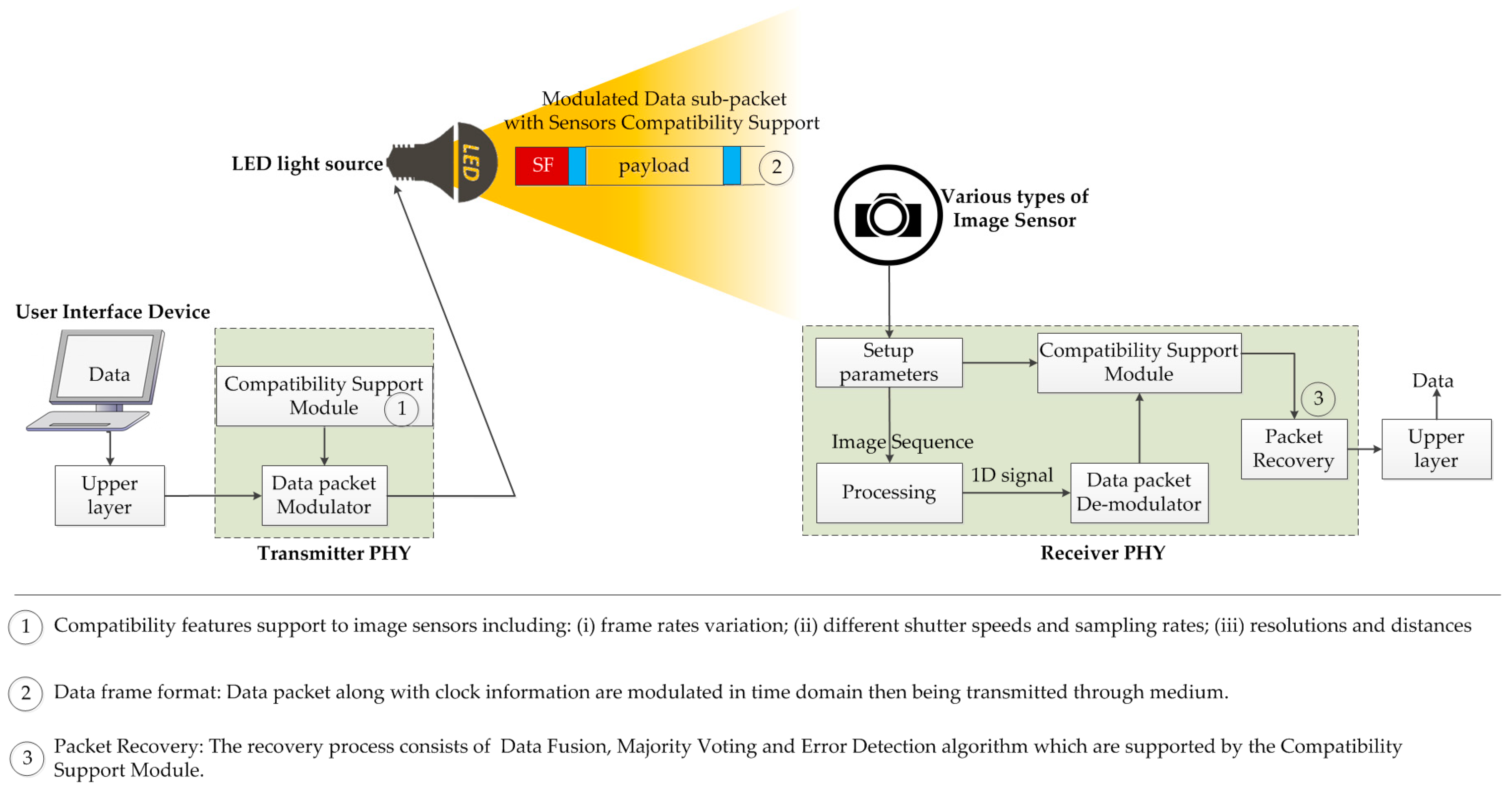
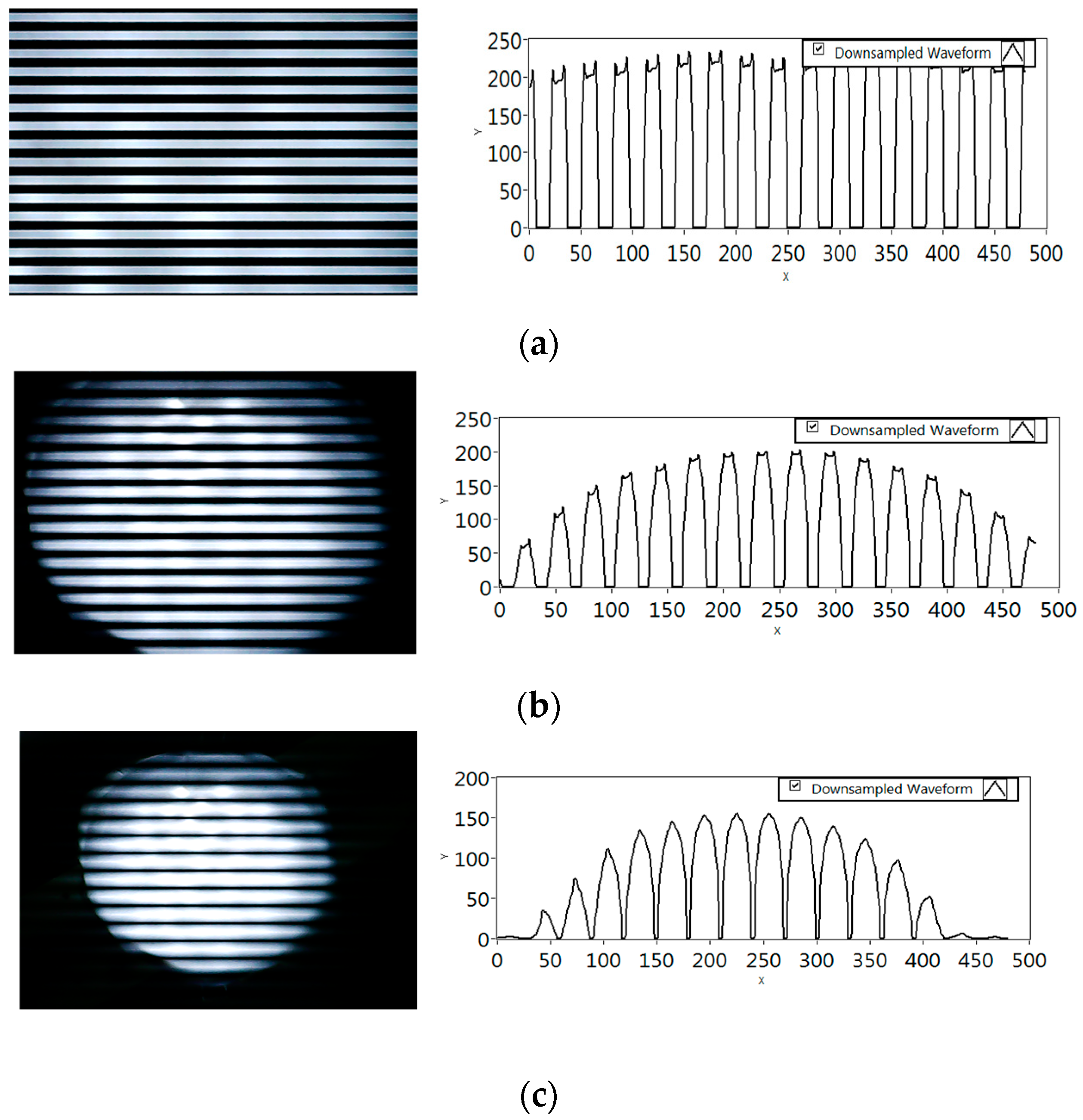
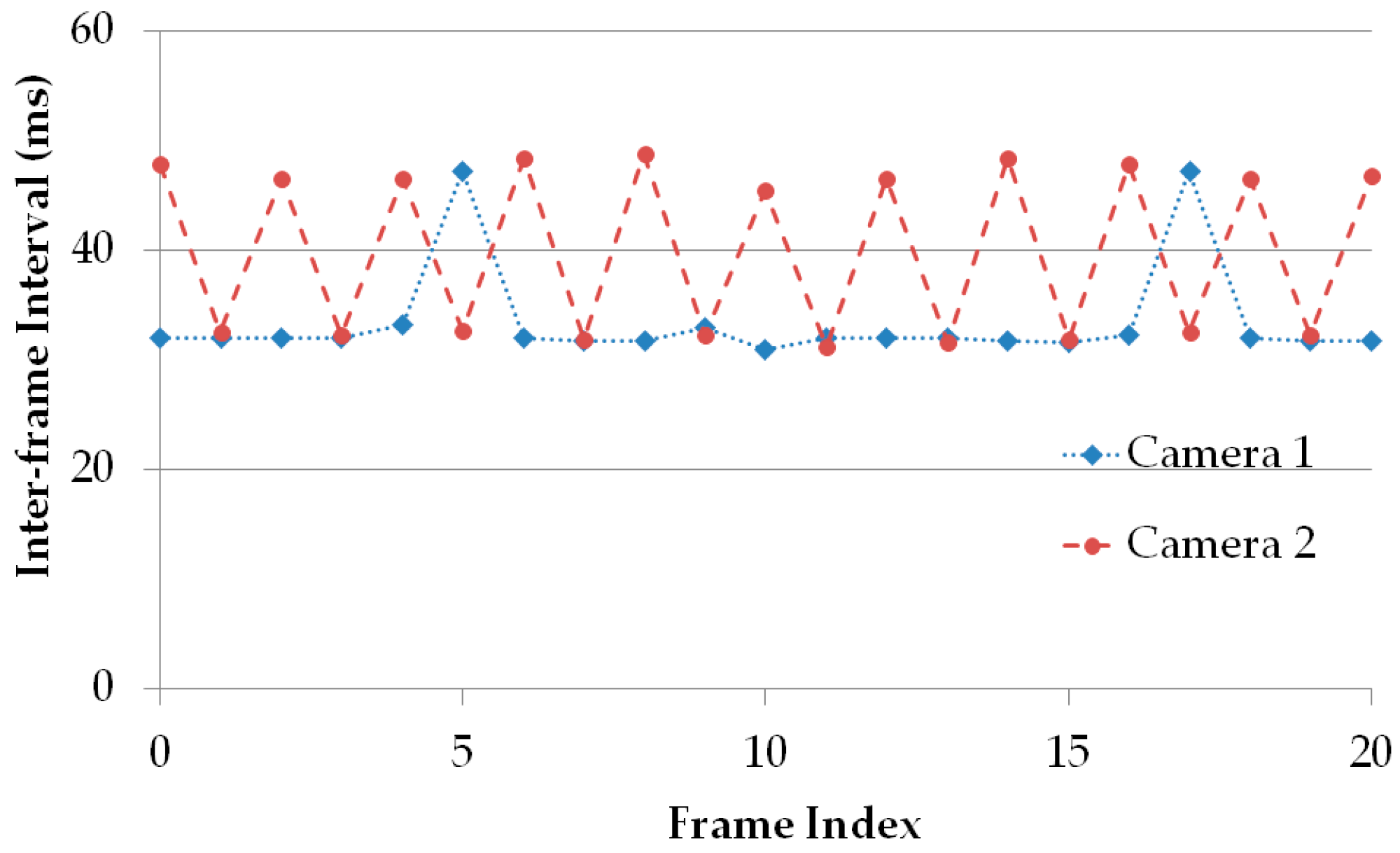



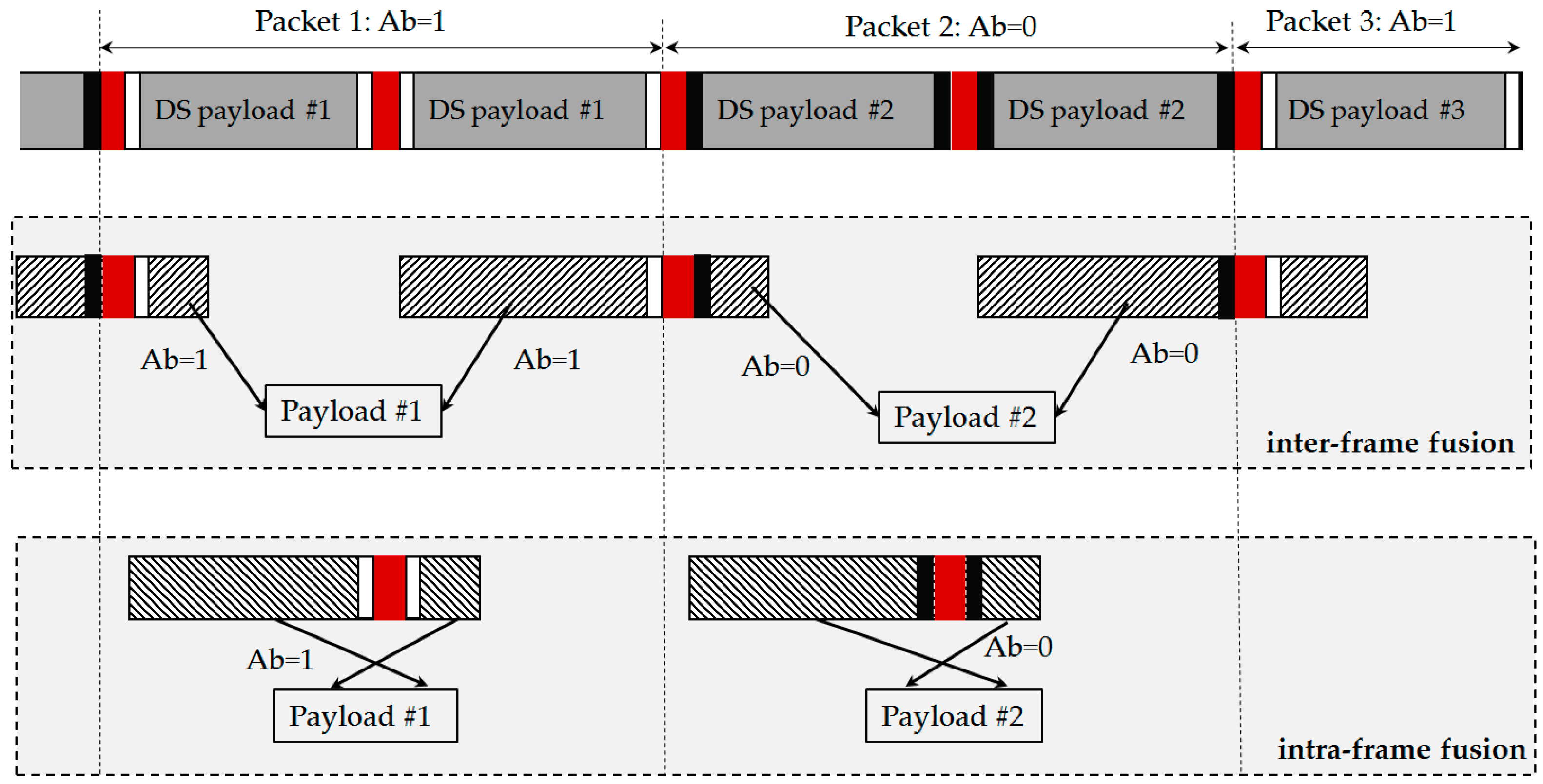



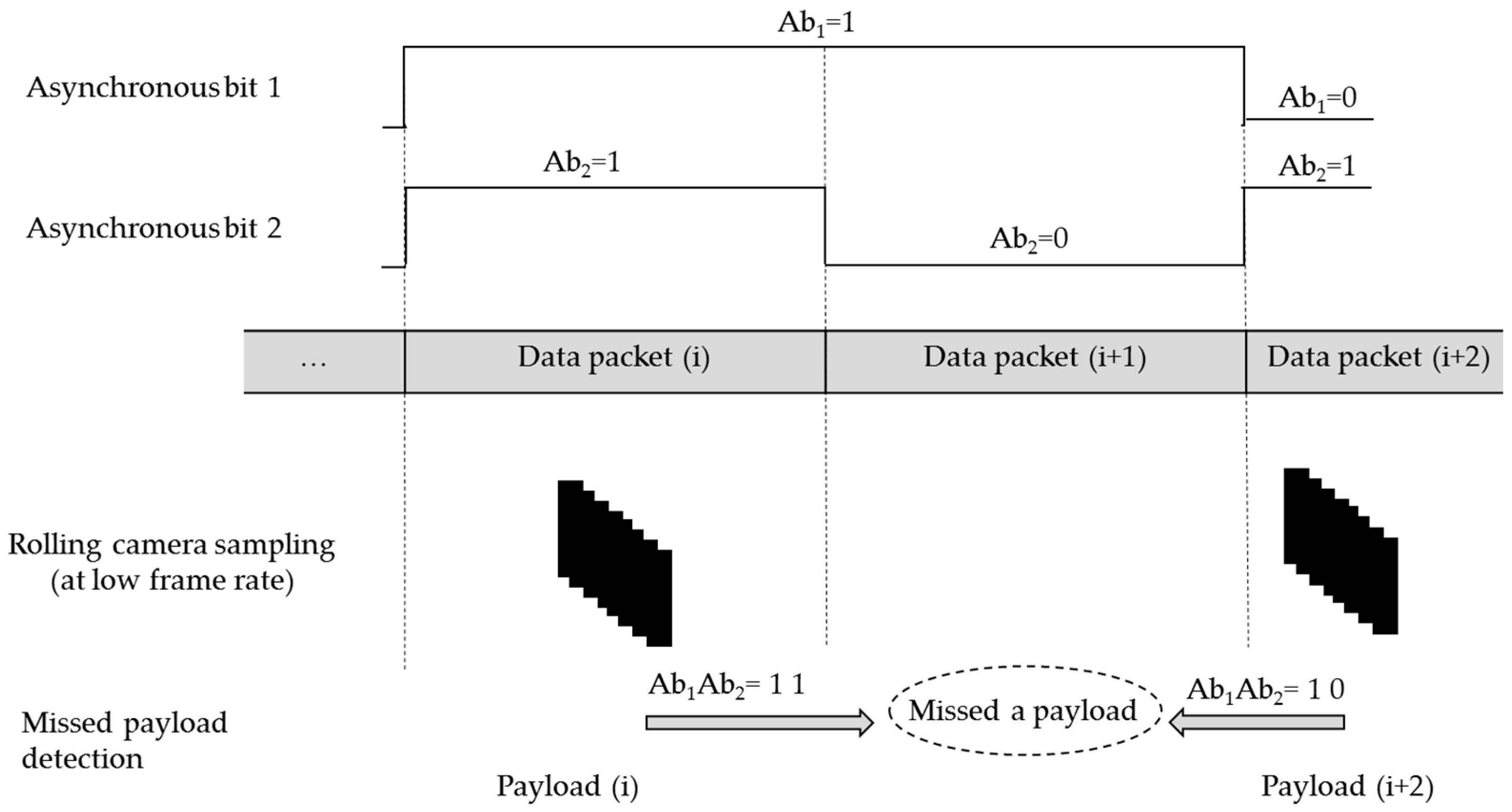
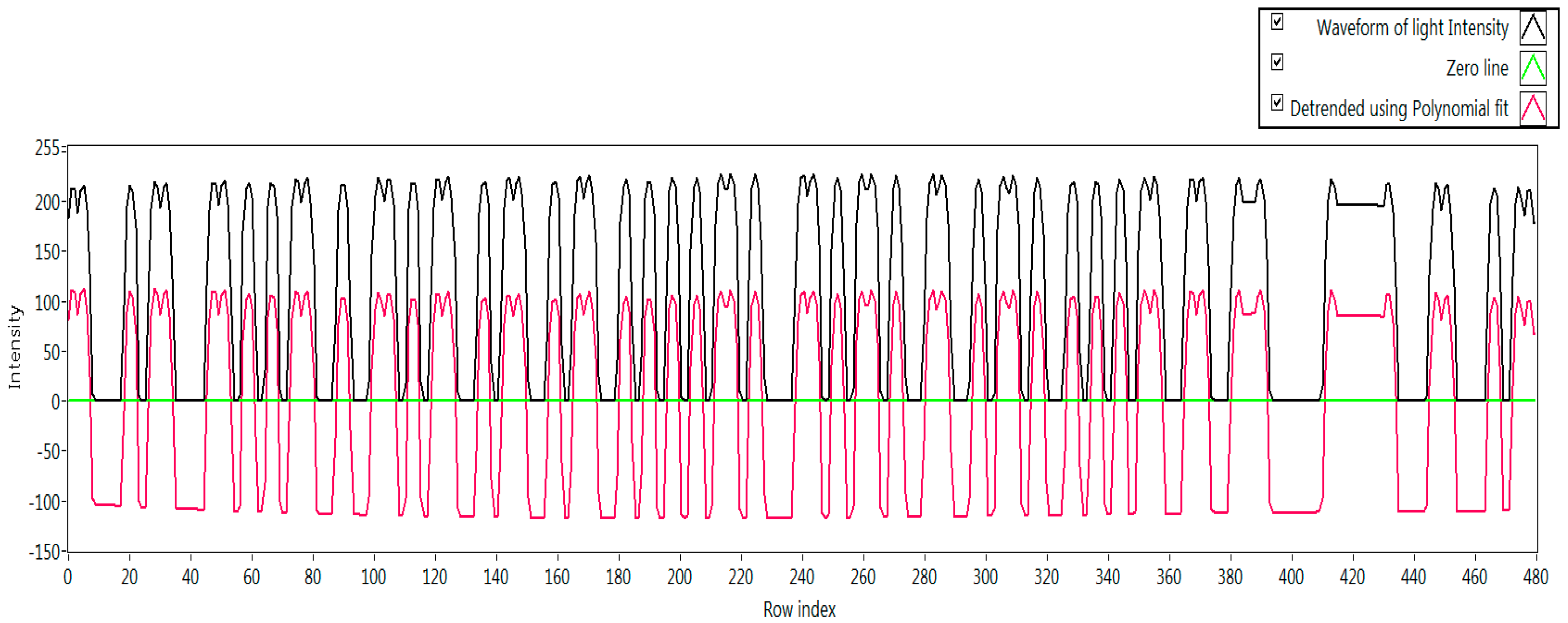
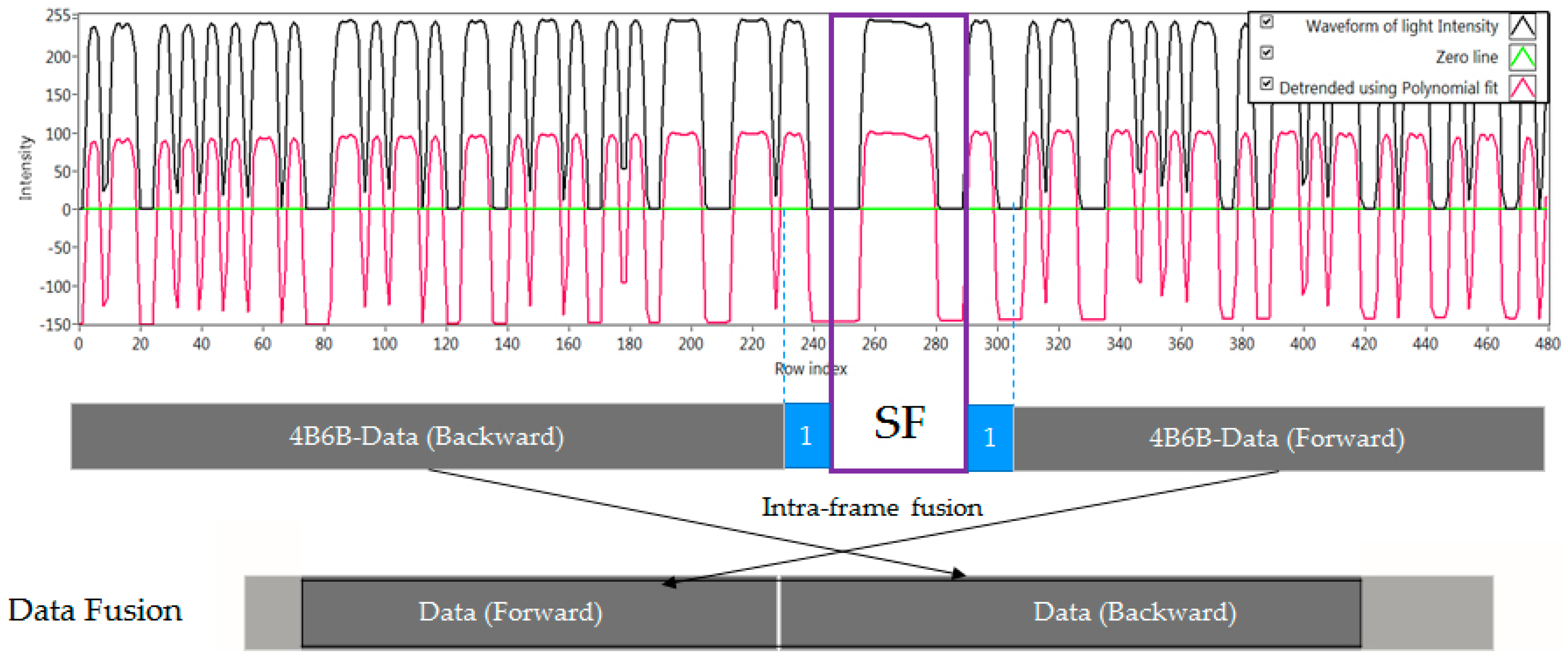
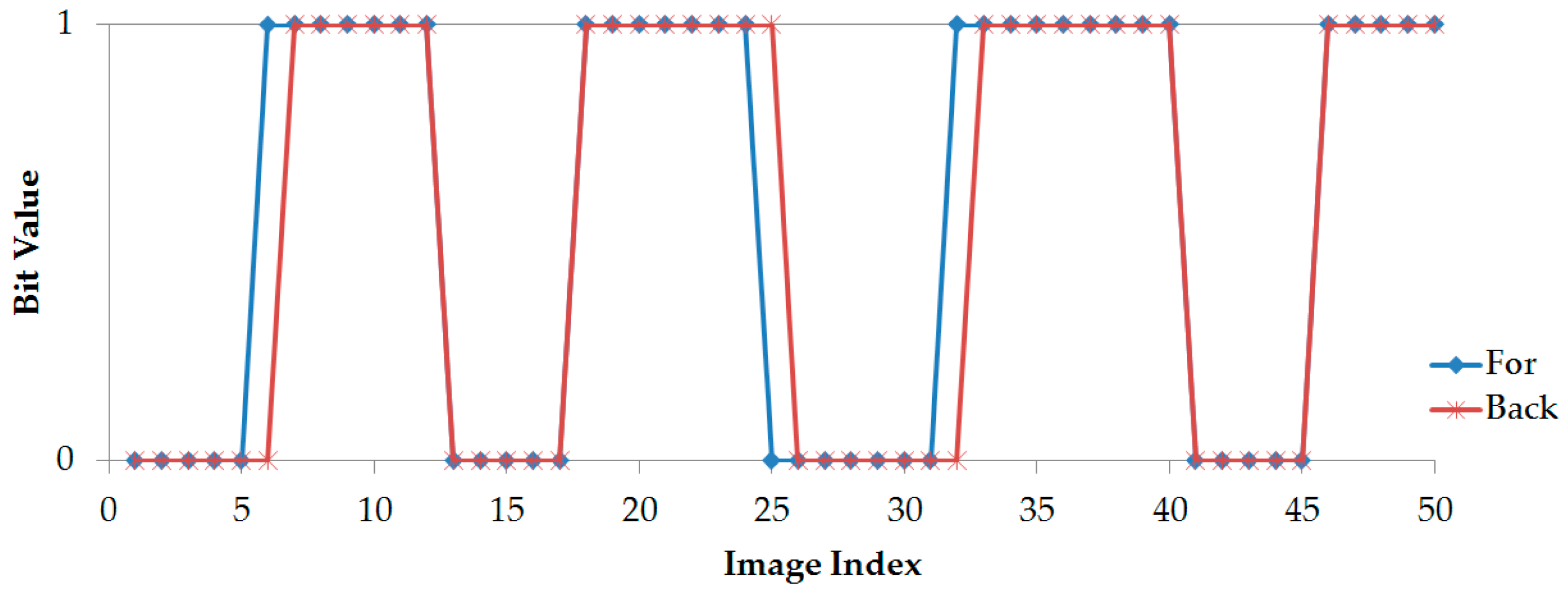
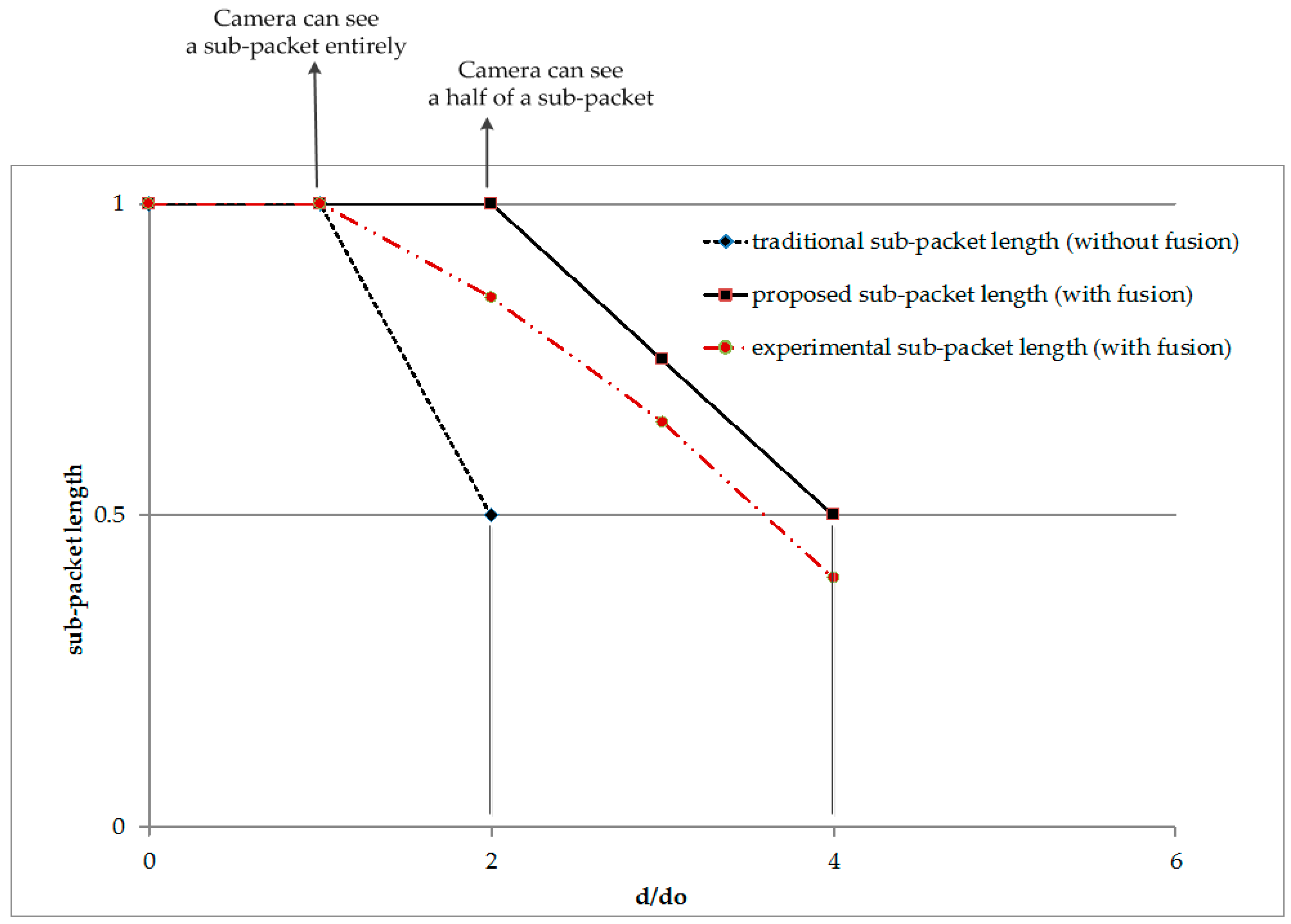
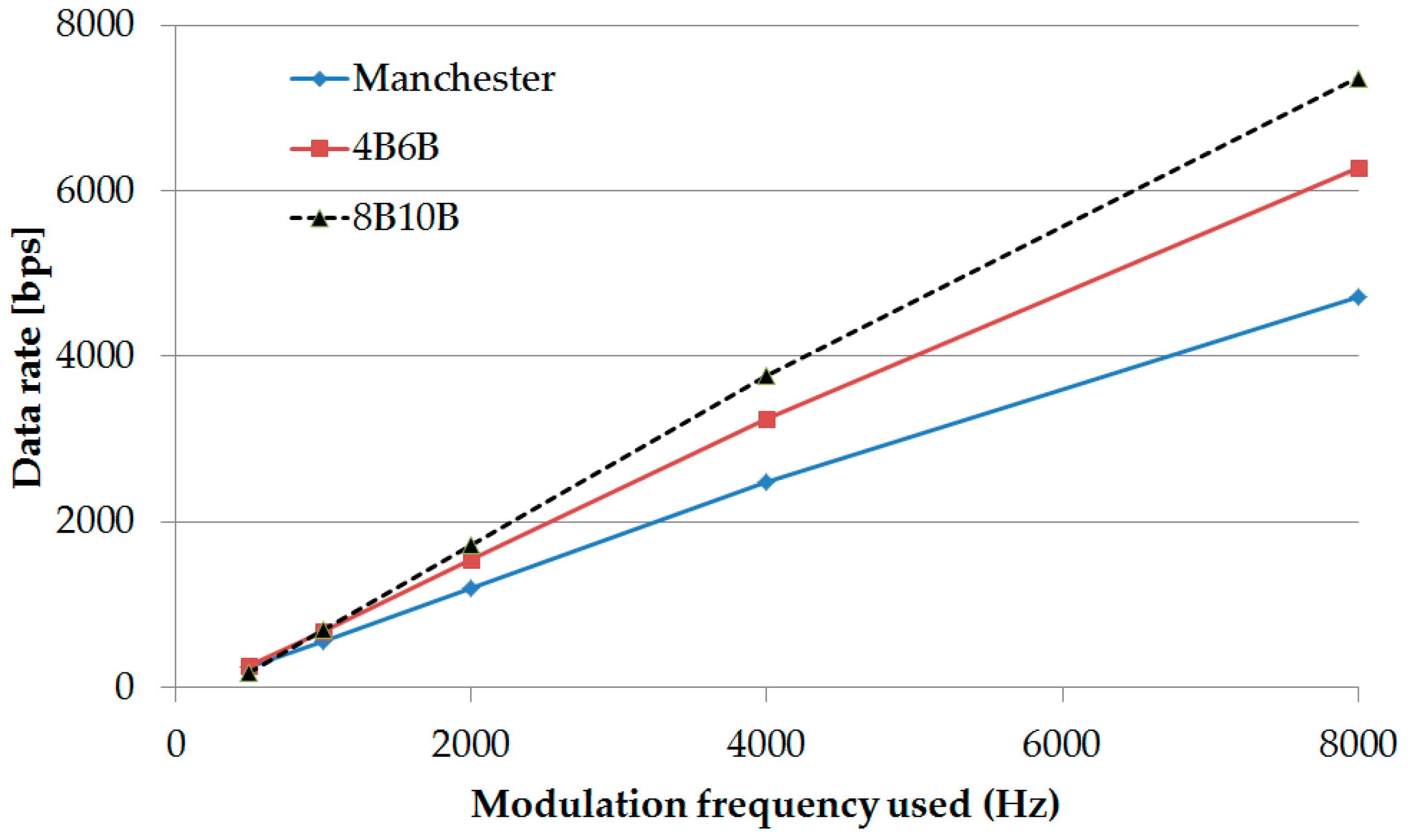
| Modulation Scheme | Rolling Shutter | Global Shutter |
|---|---|---|
| On-Off-Keying (OOK) |
| |
| Frequency-Shift-Keying (FSK) |
| |
| Variable Pulse Position Modulation (VPPM) |
| |
| Phase-Shift-Keying (PSK) |
|
|
| Contribution | Necessity | Effectiveness |
|---|---|---|
Proposed data frame structure #1 consists of
|
| Overhead 3 includes a short preamble and two asynchronous bits at the beginning and the ending of the sub-packet. |
Proposed data frame structure #2 consists of
|
| Two bits overhead additionally. |
| Term (Synopsis) | Definition | Description |
|---|---|---|
| Data Sub-packet (DS) | A pack of information clocked out, including a preamble, asynchronous bits, and a payload. A sub-packet is counted from the starting of a preamble symbol to the starting of the next preamble symbol. A data sub-packet is shortly called a sub-packet, and being denoted as DS. | Figure 4 |
| Data packet | The set of data sub-packets which includes a sub-packet and its multiple-times-repetition. | Figure 4 |
| Packet rate | The number of different data packets across the transmission medium per time. It shows how fast the data packet is clocked out (e.g., 10 packets/s). A data packet consists of multiple DS. All those DS are same and each of them brings a similar payload. | Figure 4 and Figure 5 |
| DS rate | The frequency at which the DS is clocked out to the transmission medium. | Figure 4 |
| Start Frame (SF) | The pre-defined symbol to be inserted at the starting of every sub-packet. The SF is a preamble which is same on every sub-packet DS. | Figure 4 |
| DS payload | A DS payload is the amount of data (the body data) of a data sub-packet DS. DS payload is also shorten as the payload. A payload is encoded along with asynchronous bits and a preamble to form a sub-packet. A data packet has multiple sub-packets but all those sub-packet bring the same payload. | Figure 4 and Figure 5 |
| Clock information (of a data packet) | The information represents the state of a packet clocked out. The clock information is transmitted along with a DS payload in every sub-packet to help a receiver in identifying an arrival state of the new packet under the presence of the frame rate variation. | Figure 5 |
| Asynchronous bit (Ab) | A form of the clock information in the temporal scheme helping a varying frame rate receiver in asynchronous decoding. In our scheme, a single or a couple of asynchronous bit(s) is used representing the clock information. However, note that the clock information is not only necessarily one single bit (bit 1 or bit 0), but also can be a symbol (a set of bits in which symbol 1 and symbol 0 are orthogonal somehow) to operate at high noise affected. | Figure 5 |
| Over-sampling scheme | The communication scheme in which the frame rate of a rolling shutter camera is greater than the packet rate of the transmission. | Figure 6 and Figure 7 |
| Data fusion | A process in asynchronous decoding to group two or more than two incomplete data parts (forward parts and backward parts) those belong to one complete packet. Two statements of data fusion include:
| Figure 7 |
| Asynchronous decoding | The decoding procedure under mismatched frame rates between a transmitter and a receiver due to frame rate variation. The initial step of decoding procedure is to detect the SF symbol. From the location of the SF, two sub-decoding procedures are:
| Figure 8 |
| Under-sampling scheme | The communication scheme in which the frame rate of a camera is permitted dropping to less than the packet rate of transmission. Any missed packet due to the frame rate dropping will be detected for a future process. | Figure 9 and Figure 11 |
| Topics | Manchester | 4B6B | 8B10B |
|---|---|---|---|
| Data Rate Efficiency, η | 50% | 67% | 80% |
| Shortest length of the preamble required * | 8B | 10B | 18B |
| Types of Frame Structure | Receiver’s Frame Rate (Assumption) | Transmitter’s Packet Rate (Maximum) | Features Support |
|---|---|---|---|
| Frame Structure #1—One Ab |
| 20 (packets/s) |
|
| Frame Structure #2—Couple of Ab |
| 20 (packets/s) |
|
| RLL Code | Overhead (OH) | |
|---|---|---|
| Proposed Preamble (SF) | Asynchronous Bit | |
| Manchester | 011100 | 2 bits/4 bits per packet |
| 4B6B | 0011111000 | |
| 8B10B | 0000111111111100000 | |
| Ab | 1 | 1 | 1 | 1 | 1 | 1 | 1 | 0 | 0 | 0 | 0 | 0 | 1 | 1 | 1 | 1 | 1 | 1 | 1 | 1 | 0 | 0 | 0 | 0 | 0 | 0 |
| Forward Data (Char Type) | 0 | 0 | 0 | 0 | 0 | 0 | 0 | a | a | a | a | a | 0 | 0 | 0 | 0 | 0 | 0 | 0 | 0 | a | a | a | a | a | a |
| 1 | 1 | 1 | 1 | 1 | 1 | 1 | b | b | b | b | b | 1 | 1 | 1 | 1 | 1 | 1 | 1 | 1 | b | b | b | b | b | b | |
| 2 | 2 | 2 | 2 | 2 | 2 | 2 | c | c | c | c | c | 2 | 2 | 2 | 2 | 2 | 2 | 2 | 2 | c | c | c | c | c | c | |
| 3 | 3 | 3 | 3 | 3 | 3 | d | d | d | d | d | 3 | 3 | 3 | 3 | 3 | 3 | 3 | d | d | d | d | d | d | |||
| 4 | 4 | 4 | 4 | e | e | e | e | 4 | 4 | 4 | 4 | e | e | e | e | e | ||||||||||
| 5 | 5 | 5 | f | f | f | 5 | 5 | 5 | f | f | f | |||||||||||||||
| 6 | 6 | g | g | 6 | 6 | g | g | |||||||||||||||||||
| 7 | 7 | |||||||||||||||||||||||||
| Grouping | 7 samples | 5 samples | 8 samples | 6 samples | ||||||||||||||||||||||
| Voted Data | 01234567 | abdcefg | 01234567 | abcdefg | ||||||||||||||||||||||
| Transmitter Side | ||||
| RLL code | Manchester | 4B6B | ||
| Optical clock rate | 1 kHz | 2 kHz | 2 kHz | |
| Packet rate | 10 packet/s | |||
| LED type | 15 W | |||
| Receiver Side | ||||
| Camera type | USB Webcam | |||
| Camera frame rate | 20 fps to 35 fps | |||
| Throughput | ||||
| Bit rate limit (free error) | 0.6 kbps | 1.2 kbps | 1.9 kbps | |
| Achieved bit rate throughput (free error) | 0.3 kbps | 0.5 kbps | 0.6 kbps | |
© 2016 by the authors; licensee MDPI, Basel, Switzerland. This article is an open access article distributed under the terms and conditions of the Creative Commons Attribution (CC-BY) license (http://creativecommons.org/licenses/by/4.0/).
Share and Cite
Nguyen, T.; Hossain, M.A.; Jang, Y.M. Design and Implementation of a Novel Compatible Encoding Scheme in the Time Domain for Image Sensor Communication. Sensors 2016, 16, 736. https://doi.org/10.3390/s16050736
Nguyen T, Hossain MA, Jang YM. Design and Implementation of a Novel Compatible Encoding Scheme in the Time Domain for Image Sensor Communication. Sensors. 2016; 16(5):736. https://doi.org/10.3390/s16050736
Chicago/Turabian StyleNguyen, Trang, Mohammad Arif Hossain, and Yeong Min Jang. 2016. "Design and Implementation of a Novel Compatible Encoding Scheme in the Time Domain for Image Sensor Communication" Sensors 16, no. 5: 736. https://doi.org/10.3390/s16050736
APA StyleNguyen, T., Hossain, M. A., & Jang, Y. M. (2016). Design and Implementation of a Novel Compatible Encoding Scheme in the Time Domain for Image Sensor Communication. Sensors, 16(5), 736. https://doi.org/10.3390/s16050736







